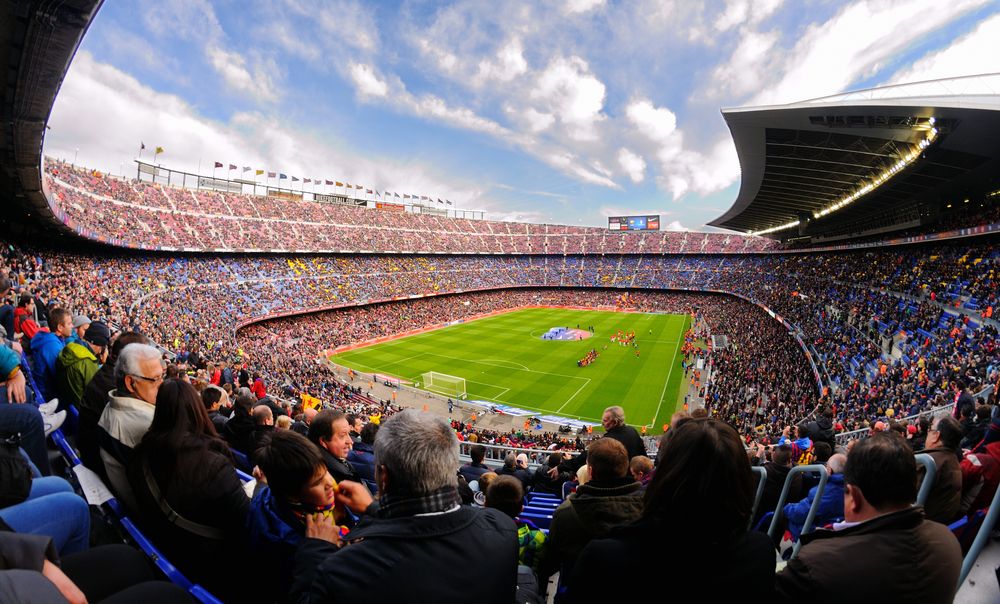The Ultimate Pilgrimage: Five Soccer Stadiums Every Fan Must Visit
Soccer is a game that is loved all over the world. Some soccer stadiums have become places of worship. In this article, we mention five soccer stadiums that every soccer fan should visit.

There's something profoundly magical about the hum of anticipation just before kickoff in a soccer stadium. It's a sound that thrums with hope, excitement, and an undercurrent of competition. The stadium comes alive, its energy a palpable force fueled by the collective passion of thousands of devoted fans. For the true soccer enthusiast, there is a worldwide trail of hallowed grounds, each teeming with its own unique history, charm, and unmatched atmosphere.
The beautiful game, as we know it, has been carved out in these coliseums, marked by unforgettable moments of glory, heartbreak, triumph, and spirit. Every cheer, every chant, and every wave of applause echoes decades, even centuries, of tradition. These are not just architectural marvels but living, breathing entities that capture the very essence of football's allure.
This article takes you on an enchanting journey through the ten must-visit soccer stadiums around the globe. Whether you're an avid soccer follower, an aspiring player, or someone who appreciates the inherent thrill of sport, these cathedrals of soccer are much more than a spectacle—they represent an essential pilgrimage in your lifelong affair with football. Prepare to step into the heart of the action, where every goal is a shared victory and every match is a shared history.
Camp Nou (Barcelona, Spain)
Camp Nou, located in Barcelona, Spain, is the home ground of FC Barcelona, one of the world's most renowned football clubs.
The construction of Camp Nou started on March 28, 1954, as Barcelona's previous stadium, Camp de Les Corts, could not be expanded due to a lack of space. The new stadium was designed by architects Francesc Mitjans and Josep Soteras, with the collaboration of Lorenzo García Barbón. Completed in 1957, the stadium has undergone renovations over the years, particularly for major tournaments. As of my knowledge cutoff in September 2021, Camp Nou is the largest stadium in Europe and the third-largest football stadium in the world in terms of capacity, holding approximately 99,354 spectators.
Camp Nou has been the venue for several major football events. It hosted the 1982 FIFA World Cup semi-final match, the 1999 UEFA Champions League final, and numerous Copa Del Rey (King's Cup) finals. It's the place where numerous great players, such as Johan Cruyff, Diego Maradona, Ronaldinho, and Lionel Messi, have displayed their talents.
The stadium isn't just about the pitch and the stands; it houses the FC Barcelona Museum, which attracts more than 1.2 million visitors per year. The museum showcases interactive walls, new showcases, and a wide collection of objects revealing the history of FC Barcelona. It's also the place where fans can explore the club's values and touch upon its emotions.
Camp Nou is famous for the atmosphere during its matches. The stadium often becomes a sea of blue and claret (the team's colors) when the team plays crucial matches. The fans, called 'Culés,' are known for their passion and support for the team, contributing to the unique matchday atmosphere.
The stadium is set for a major renovation under the Espai Barça project, which aims to transform Camp Nou into a state-of-the-art stadium with 105,000 seats for a top-quality sporting experience. The project is expected to be completed by 2026.
Wembley Stadium (London, England)
The current Wembley Stadium was built on the site of the original Wembley Stadium, which was demolished in 2002–2003. The original stadium, known as the "Empire Stadium," was constructed as the centerpiece of the British Empire Exhibition in 1924 and had been an emblem of British sports for many decades. The new Wembley Stadium, with a striking arch that can be seen across London, was opened in 2007 after several years of reconstruction. Designed by architects Foster and Partners and HOK Sport (now Populous), the current stadium has a capacity of 90,000, making it the second-largest stadium in Europe.
Wembley has hosted some of the most significant events in football history. It's the home venue for the England national football team and hosts major domestic finals such as the FA Cup, the League Cup, and the Community Shield. Wembley has also hosted the UEFA Champions League Finals in 2011 and 2013. During the 2012 Olympics, the stadium was a significant venue, particularly for football events.
One of Wembley's most recognizable features is the Wembley Arch. This 134-meter-high steel arch is the world's longest single-span roof structure and a significant feature of London's skyline. The stadium's retractable roof, when closed, covers every seat in the stadium, a feature that protects spectators without obscuring sunlight from reaching the pitch.
The atmosphere in Wembley during a match is electrifying, with passionate fans adding to the high-energy environment. The acoustics are designed to reflect the noise back to the stadium, enhancing the atmosphere.
Estadio Azteca (Mexico City, Mexico)
Built in 1966 and designed by architects Pedro Ramírez Vázquez and Rafael Mijares Alcérreca, Estadio Azteca is the third-largest football stadium in the world and the largest in Mexico, with a capacity of around 87,523. It is the first stadium to have hosted two FIFA World Cup Finals—in 1970 and 1986.
In addition to the two World Cup finals, Estadio Azteca has hosted numerous other crucial international matches. One of the most famous moments in football history occurred at this stadium: Diego Maradona's 'Hand of God' goal and the 'Goal of the Century' against England in the 1986 World Cup quarterfinal.
The stadium is the home ground for Club América, one of the most successful clubs in Mexican football. It has also occasionally hosted games for the Mexico national team and Cruz Azul.
Estadio Azteca is known for its enormous size and the vibrant atmosphere its fans create. Its design allows for excellent visibility from all seating areas, contributing to the electric matchday atmosphere.
The atmosphere at Estadio Azteca is often described as intense and intimidating, particularly for visiting teams. The Mexican fans are incredibly passionate, creating a lively and exciting matchday experience.
Estadio Azteca will be completely renovated to be ready for the 2026 World Cup. The modernization will be extensive, and as a result, the facility will be out of use for the duration of the renovation.
Maracanã (Rio de Janeiro, Brazil)
The Maracanã Stadium, officially known as Estádio Jornalista Mário Filho, is one of the most historic and iconic football stadiums in the world, located in Rio de Janeiro, Brazil.
Opened in 1950 to host the FIFA World Cup, the Maracanã was once the world's highest-capacity football venue, able to accommodate nearly 200,000 spectators at its peak. Its capacity has been reduced over the years due to safety measures and renovations; it has a seating capacity of approximately 78,838.
The Maracanã is notable for hosting the 1950 World Cup final, where Brazil suffered a dramatic loss to Uruguay in a match famously referred to as the "Maracanazo". The match still holds the record for the highest attendance at any FIFA World Cup match, with an estimated 200,000 spectators. The stadium also hosted the World Cup Final in 2014 and the opening and closing ceremonies of the 2016 Olympics.
The Maracanã is home to four of Rio's biggest football clubs: Flamengo, Fluminense, Botafogo, and Vasco da Gama, who regularly use the stadium for high-profile matches.
The stadium has a circular design, which gives it the appearance of a round colosseum, providing excellent views for spectators. It also houses a sports museum that showcases memorabilia related to Brazilian football, including a tribute to the teams that played in the 1950 World Cup.
The atmosphere at the Maracanã is famous worldwide. Brazilian fans, known for their passion for football, create a festive, carnival-like atmosphere during matches, full of samba music, cheering, and flag-waving.
La Bombonera (Buenos Aires, Argentina)
La Bombonera, officially known as Estadio Alberto J. Armando, is one of the most famous football stadiums in the world.
La Bombonera, which translates to 'The Chocolate Box' due to its shape, opened on May 25, 1940. The architect behind the unique design was Slovenian-born Viktor Sulčič. The stadium's seating capacity is approximately 54,000. However, during some of the most crucial matches, the number of spectators has been known to surpass this.
La Bombonera is especially known for the Superclásico – the highly intense and fiercely contested matches between local rivals Boca Juniors and River Plate. These matches are renowned globally for their passionate fans, electric atmosphere, and high-quality football.
The stadium has hosted several international matches as well, including games during the 1978 World Cup, and the first round of the Copa América in 1987.
What makes La Bombonera unique is its design. It has a flat side (on one of the shorter ends of the stadium), a vertical side (on the opposite shorter end), and steep stands, creating a 'D'-shape overall. This design amplifies the noise levels inside the stadium, contributing to its notorious atmosphere.
The stadium also houses the Museo de la Pasión Boquense (Boca Juniors' Museum), which showcases the history of the club and contains numerous exhibits of memorabilia.
The atmosphere at La Bombonera is electric and intense, making it one of the most intimidating environments for visiting teams. The Boca Juniors' fans, known as the 'La Doce' (The Twelfth Man), are incredibly passionate, singing and cheering throughout matches, creating a wall of noise that reverberates through the stadium.
There are plans to recreate a Nuevo Bombonera before the 2030 World Cup, which might be hosted in Argentina.




